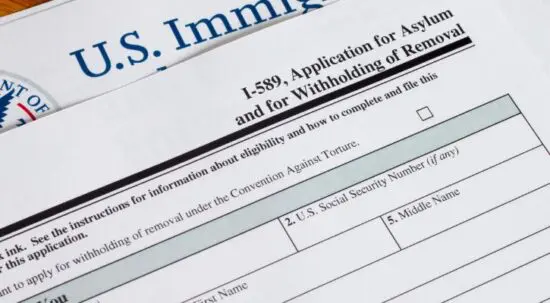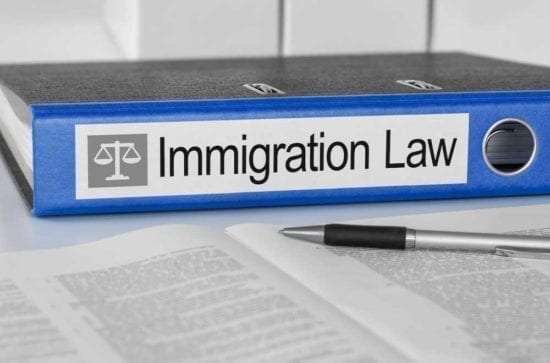Tị nạn là gì?
Xin tị nạn là một hình thức xin biện pháp bảo vệ mà cho phép bạn ở lại Canada. Nộp đơn xin tị nạn ở Canada còn được gọi là đưa ra yêu cầu xin làm người tị nạn. Người xin tị nạn hoặc đối tượng yêu cầu làm người tị nạn khác với những người tị nạn thuộc diện tái định cư.
(https://www.youtube.com/watch?v=RYiDM0LZ5pM)
Bạn có thể nộp đơn xin tị nạn ở Canada nếu bạn là người tị nạn theo công ước hoặc một người cần được bảo vệ.
- Người tị nạn theo công ước là người lo sợ bị áp bức ở quốc gia quê hương mình vì lý do chủng tộc, tôn giáo, quốc tịch, quan điểm chính trị và nhóm xã hội.
- Người cần được bảo vệ là người lo sợ bị áp bức hoặc nguy hiểm nếu họ bị trục xuất về nước (hoặc quốc gia nơi họ thường sinh sống).
- Áp bức có thể bao gồm tổn hại nghiêm trọng về thể chất hoặc tinh thần, tra tấn, giam giữ và đe dọa.
Lợi ích của việc xin tị nạn là gì?
Khi được cấp tình trạng tị nạn, bạn có thể:
- Ở lại Canada hợp pháp với sự đảm bảo không bị giam giữ và trục xuất
- Xin tị nạn cho vợ/chồng và con của bạn
- Làm việc và học tập tại Canada
- Du lịch bên ngoài Canada
- Nộp đơn xin trở thành thường trú nhân và công dân tại Canada
- Nhận hỗ trợ chăm sóc sức khỏe và tái định cư, bao gồm trợ giúp tài chính, đào tạo ngôn ngữ, trợ giúp việc làm trong tối đa một năm
Tôi có thể xin tị nạn tại biên giới Canada-Hoa Kỳ không?
Nhìn chung, những người nhập cư từ Hoa Kỳ không thể nộp đơn xin tị nạn tại biên giới Canada-Hoa Kỳ. Canada có một thỏa thuận với Hoa Kỳ yêu cầu mọi người phải nộp đơn xin làm người tị nạn hoặc xin tị nạn ở quốc gia an toàn đầu tiên họ đến. Điều này được gọi là Hiệp định quốc gia thứ ba an toàn (STCA).
- STCA áp dụng cho người xin tị nạn tại các cửa khẩu biên giới chính thức và không chính thức. Nếu bạn đi qua Hoa Kỳ và vào Canada tại cảng biên giới đất liền hoặc bằng tàu hỏa, bạn không thể nộp đơn xin làm người tị nạn hoặc yêu cầu tị nạn khi nhập cảnh vào Canada.
- STCA được mở rộng trên toàn bộ biên giới đất liền. Hiện nay bao gồm cả các cửa khẩu biên giới không chính thức như Đường Roxham giữa Quebec và New York. Bạn sẽ bị từ chối và được hướng dẫn nộp đơn khiếu nại tại Hoa Kỳ.
- STCA cũng áp dụng cho người xin tị nạn hoặc người xin tị nạn vượt biên giới và nộp đơn xin tị nạn trong vòng chưa đầy 14 ngày sau khi đến nơi.
- Nếu bạn bị từ chối tình trạng tị nạn ở Hoa Kỳ và bay đến Canada, bạn cũng sẽ bị từ chối ngay tại sân bay.
| Tương tự, nếu bạn đi qua Canada trước và sau đó vào Hoa Kỳ, bạn thường không thể nộp đơn xin tị nạn tại biên giới ở Hoa Kỳ. Bạn sẽ được đưa trở lại Canada trừ khi bạn đủ điều kiện cho một trường hợp ngoại lệ. |
Có trường hợp ngoại lệ nào không?
Có. Có những ngoại lệ đối với STCA. Bạn có thể nộp đơn xin tị nạn ở Canada tại biên giới nếu:
- Bạn có một thành viên gia đình là người tị nạn, người được bảo vệ, thường trú nhân hoặc công dân Canada.
- Bạn là trẻ vị thành niên chưa lập gia đình (dưới 18 tuổi) và không có mẹ, cha hoặc người giám hộ hợp pháp ở Canada hay Hoa Kỳ.
- Bạn có giấy tờ nhập cảnh hợp lệ như thị thực Canada, giấy phép lao động, giấy phép du học hoặc giấy tờ thông hành.
- Bạn đã bị buộc tội hoặc kết án là phạm tội có thể bị tử hình ở Hoa Kỳ hoặc một quốc gia khác. Bạn không được là một rủi ro an ninh, hoặc nguy hiểm cho công chúng, hoặc đã vi phạm tội nghiêm trọng hoặc nhân quyền hay quyền quốc tế.
Quy tắc Quốc gia thứ ba an toàn cũng không áp dụng nếu:
- Bạn đã đến Canada qua sân bay hoặc cảng biển
- Bạn là công dân Hoa Kỳ hoặc người không quốc tịch đã sống ở Hoa Kỳ trong một thời gian dài
Bạn vẫn phải đáp ứng tất cả các yêu cầu khác để nộp đơn xin tị nạn ở Canada.
Tôi có thể xin tị nạn nếu tôi đã ở Canada không?
Có. Quy tắc quốc gia thứ ba an toàn chỉ áp dụng cho người xin tị nạn ở biên giới Canada-Hoa Kỳ. Bạn có thể xin tị nạn tại văn phòng IRCC hoặc trực tuyến nếu bạn đã ở Canada. Bạn có thể nộp đơn ngay cả khi bạn đã đi qua Hoa Kỳ trước nhưng bạn phải nộp đơn sau khi ở Canada ít nhất 14 ngày.
Bạn cần đáp ứng những yêu cầu gì?
Để xin tị nạn ở Canada, bạn phải:
- Có mặt tại Canada
- Là người tị nạn theo công ước hoặc là người cần được bảo vệ
- Chưa đi qua quốc gia thứ ba an toàn (USA)
- Chưa từng nộp đơn xin tị nạn hoặc xin tị nạn ở một quốc gia khác
- Không phạm một số tội nhất định hoặc bị coi là mối đe dọa đối với an ninh Canada
Tôi có thể nộp đơn xin tị nạn như thế nào?
Bạn có thể nộp đơn xin tị nạn ở Canada nếu bạn đáp ứng các yêu cầu.
Trực tiếp
Bạn có thể yêu cầu tình trạng tị nạn nếu STCA không áp dụng cho bạn. Bạn có thể nộp đơn xin tị nạn trực tiếp tại cảng nhập cảnh khi đến Canada. Cảng nhập cảnh bao gồm tất cả các sân bay, cảng biển hoặc biên giới đất liền.
Một chuyên viên dịch vụ biên giới sẽ yêu cầu bạn điền vào đơn. Bạn cũng có thể nộp đơn xin tị nạn tại văn phòng IRCC.
Trực tuyến
Nếu bạn đã ở Canada, bạn có thể nộp đơn xin tị nạn trực tuyến. Bạn sẽ phải tạo một tài khoản để sử dụng cổng thông tin IRCC.
Điều gì xảy ra sau khi tôi nộp đơn?
Các viên chức của Cơ quan dịch vụ biên giới Canada (CBSA) hoặc Bộ di trú, người tị nạn và quốc tịch Canada (IRCC) sẽ xem xét đơn xin của bạn và sẽ hỏi bạn các câu hỏi về yêu cầu của bạn. Bạn sẽ phải lấy sinh trắc học, nộp các tài liệu khác và hoàn thành một buổi khám sức khỏe.
- Nếu yêu cầu của bạn đủ điều kiện, viên chức di trú sẽ giới thiệu bạn đến Hội đồng di trú và tị nạn Canada (IRB). Bạn sẽ phải hoàn thành và nộp mẫu đơn yêu cầu cho IRB. Trong phiên điều trần, bạn và bất kỳ nhân chứng nào sẽ có cơ hội làm chứng về yêu cầu của bạn.
- Nếu IRB chấp thuận yêu cầu của bạn, bạn sẽ nhận được tình trạng người được bảo vệ và sẽ có thể nộp đơn để trở thành thường trú nhân tại Canada.
- Nếu IRB từ chối yêu cầu của bạn, bạn sẽ phải rời khỏi Canada. Bạn có thể kháng cáo trường hợp của mình.
- Bạn có thể nhận được hỗ trợ tái định cư, dịch vụ chăm sóc sức khỏe và trợ giúp tài chính trong khi chờ phiên điều trần của bạn. Bạn cũng có thể xin giấy phép lao động hoặc giấy phép học tập trong khi chờ quyết định.
Tôi có thể nhận trợ giúp pháp lý bằng cách nào?
Một luật sư di trú hoặc người đại diện pháp lý có thể giúp bạn xem xét các phương án dành cho bạn và hoàn thành đơn xin của bạn. Họ cũng có thể giúp bạn chuẩn bị cho cuộc phỏng vấn và đại diện cho bạn tại phiên điều trần. Bạn có cơ hội xin được tị nạn tốt hơn với sự trợ giúp pháp lý.
Tìm danh sách các tổ chức cung cấp trợ giúp dịch vụ pháp lý miễn phí hoặc với mức phí thấp:
- Asylex – Danh bạ chuyên nghiệp của Canada
- Canadian Bar Association – Nguồn lực trợ giúp pháp lý tại Canada
- Welcome to Canada – tìm thông tin và dịch vụ
Tìm kiếm các nguồn lực hữu ích khác của Canada cho người nhập cư và người tị nạn mới.
| Có những chương trình khác cho phép một số người nhập cư vào Canada. Bạn có thể nộp đơn xin bảo lãnh diện gia đình, việc làm hoặc tình trạng khác nếu bạn đáp ứng các yêu cầu. |
Thông tin trên trang này đến từ Government of Canada và các nguồn đáng tin cậy khác. Chúng tôi mong muốn cung cấp thông tin dễ hiểu được cập nhật thường xuyên. Thông tin này không phải là lời khuyên pháp lý.




